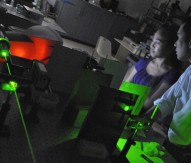
New diamond lasers developed
Groundbreaking research is harnessing the unique properties of diamonds to develop a new generation of lasers that could lead to a range of benefits, according to researchers at the University of Strathclyde in Scotland.
It’s hoped the new lasers will help better treat skin complaints and diabetes-related eye conditions as well as improve pollution monitoring and aeronautical engineering.
The team of experts have developed a new type of high performance, ultra-versatile Raman laser that harnesses diamonds to produce light beams with more power and a wider range of colours than current Raman lasers. These capabilities could open up important new applications.
Among the research results, the Strathclyde team has achieved the first ever ‘tuneable’ diamond Raman lasers, where the colour of the light can be adjusted to meet specific needs. This can be helpful in the treatment of vascular lesions (an abnormal cluster of blood vessels), for example, which requires a yellow/orange light that is difficult to produce with conventional lasers, but which is needed to maximise absorption by the lesion while minimising damage to surrounding tissue. The diamond’s optical properties enable diamond lasers to produce a range of colours that are hard to generate by conventional means.
Experts have also been able to create the first continuously-operating diamond Raman laser. Traditional lasers can often only provide short pulses of light which are unsuitable for some medical applications.
Professor Martin Dawson, who oversaw the project at Strathclyde’s Institute of Photonics, said: “Our new lasers can generate light ranging from the lower end of the ultraviolet part of the electromagnetic spectrum, right through the visible part, up to the middle of the infra-red region. That means they can plug many of the existing gaps in lasers’ capabilities.”
The four-year research programme “Diamond Raman lasers” ran from 2008 to 2012 and received £620,000 (~€735,000) from the UK’s Engineering and Physical Sciences Research Council. The research team has already secured a European Research Council Starting Grant for a follow-on project.






